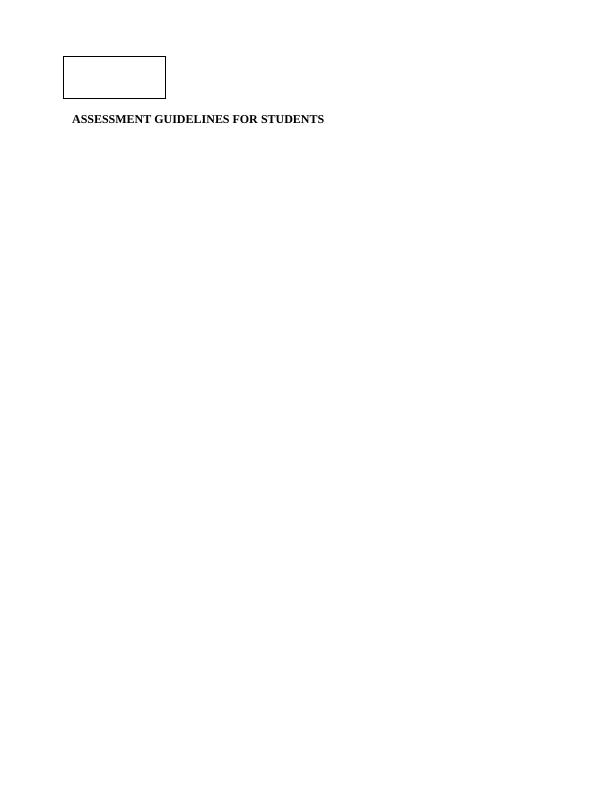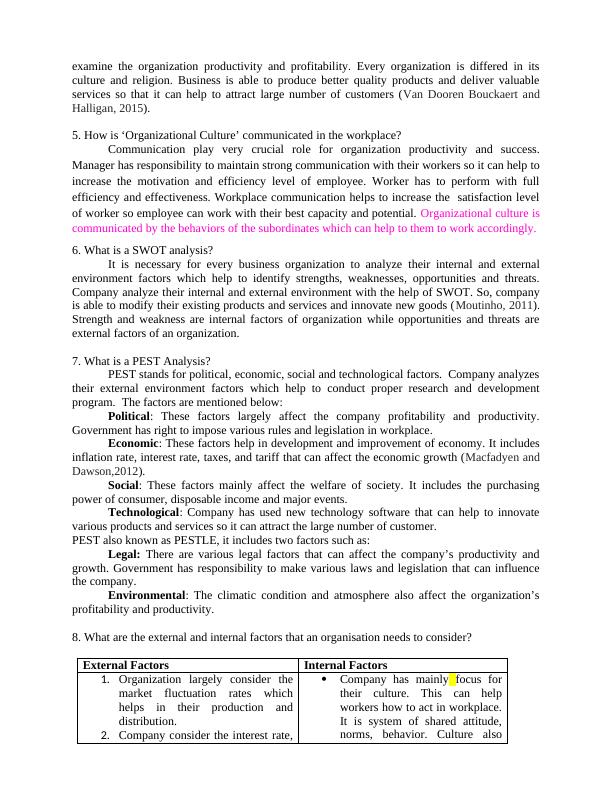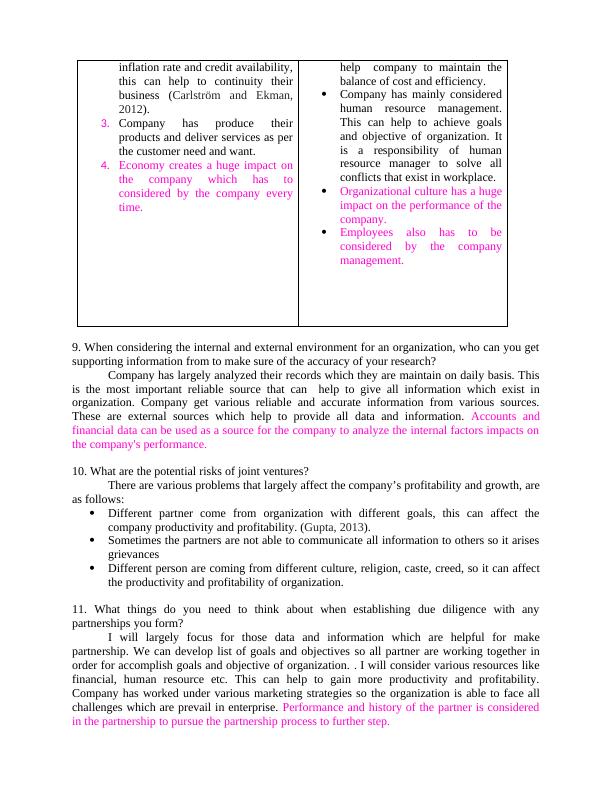Advised Diploma of Management/Advanced Diploma of Leadership and Management
33 Pages9466 Words259 Views
Added on 2020-06-04
About This Document
1 ASSESSMENT COVER SHEET QUALIFICATION:Advanced DiplomaofManagement/AdvancedDiplomaof Leadership and Management 1 UNIT NAME:Develop and implement strategic plans UNIT NAME:Develop and implement a business plan 2 ||| | | | |: | | | | | | | | | | | | | | | | | | | | | | | | | | | | | | | | | | | | | | | | | | | | | | | | | |
Advised Diploma of Management/Advanced Diploma of Leadership and Management
Added on 2020-06-04
ShareRelated Documents
ASSESSMENT COVER SHEETQUALIFICATION: Advanced Diploma of Management/Advanced Diploma of Leadershipand ManagementUNIT NAME: Develop and implement strategic plansUNIT NAME: Develop and implement a business plan:ASSESSOR tocomplete this sectionRESULT IN EACH ASSESSMENT ITEMCommentsSatisfactoryUnsatisfactoryDid not submitAssessment 1Assessment 2 – Part AAssessment 2 – Part BAssessment 3Assessment 4ASSESSOR tocomplete this section

ASSESSMENT GUIDELINES FOR STUDENTS

You need to achieve a ‘Satisfactory’ grade in ALL the assessments items to be granted a‘Competent’ grade in the unit.In case you are not able to achieve a ‘Satisfactory’ grade in any assessment task, you will be giventhree (3) attempts to resubmit your assessment. Your trainer will be available to assist you in any areas ofdifficulty. Please discuss the assessment with your trainer to seek advice on how you can achievecompetency in the unit.Where relevant, oral questions may be asked to gather more information on your knowledge,skills and competence in the unit.A holistic approach is used to assess your skills relevant to this qualification. The skills areassessed across the different units offered within this qualification. Where a skill relevant to this unit isnot assessed within this assessment pack, please note that the skill will be assessed in another unit.Additional guide to this assessment pack:You need to demonstrate your competence so do not copy from the case study; reword the answers inyour own words.Assessment Guide: Some questions will be theory based, others will require you to apply the theory tothe case study, and finally you may need to demonstrate a practical application of the theory:Theory questions – you need to demonstrate that you understand the theory. Review yourPowerPoint handout and explain the theory in your own words.Applying the theory to the case study – Review the theory in your PowerPoint handoutand read the case study. Your answer needs to show your ability to find the information from thecase study for example: What are the economic factors that Hair At home need to consider? oThe theory is...the economic climate at a local, national and international level. Can theeconomy be described as being in a period of growth or in recession, consider things such as theunemployment rate, interest rates and consumer confidence. oTo apply the theory your answer would look like....The current economic climate has beenslow over the past 12 months but Hair At Home has been able to maintain strong consumerconfidence. However there still is the potential for regular customers to reduce how frequentlythey have their hair done if they find their family budget is under stress.Practical application of the theory: Review the theory in your PowerPoint handout andread the case study. Your answer needs to show your ability to use the theory and the case study toform your answer for example: If you have identified that Jane wants to improve her profits,what course of action can or strategy can you recommend?oThe theory is... think about how I can achieve my objective or goal. Identify if there ismore than one way to do this, what are the scenarios, what results can I picture, what resourcesdo I have or need and will it fit with the current economic climate? oThe practical application will look like this...Jane could improve her profits by increasingretail sales or upselling hairdressing services this would give her additional income from thesame number of clients with very little additional expenses. Another option could be to review hertravel patterns between clients to see if she is traveling the least amount of distance in a daysaving her both travel time and motor vehicle expenses and petrol.

Assessment 1: Theory QuestionsPlease indicate whether the statements below are True or False1.True or FalseWrite True or Falsebelowa)A sole trader is also known as a single proprietorTRUEb)A partnership can have a maximum of 5 peopleFALSEc)A partnership is a separate legal entityFALSEd)A company must be registered under the Corporations Act 2001TRUEe)ACN stands for Australian Company NameFALSEf)A Licensee/Distributor/Franchisee can be a sole traderTRUEg)A Licensee/Distributor/Franchisee does not have any tradingrestrictionsFALSE2.What is the difference between strategic planning and business planning?Strategic PlanIt is a long term planning which has a set of different stages toattain the business goal (Bryson, 2011). most of the organizationsare using strategic planning for a particular years which can help tothem to attain their desired target.Business PlanIt is necessary for every business enterprise to identify theirmission, vision, goals and objectives. Company is able to gaincompetitive and sustainable advantage over other rival challengerswith the help of business plan. A situational analysis has to be donein the business plan which can help to the company to draft a planaccording to the organizational strengths, and to work on theweakness and other loopholes of the company.3.Why is it important for organization to have a strategic plan?It is necessary for every organization to make strategic plans which help for achieve goalsand objectives in long time of period. With the help of this strategic plan, manager is able toparticipate in decision making process. They can convert their ideas into reality and earn moreprofitability and productivity in long run. 4.Explain the meaning of ‘Organization Culture’.Organization culture is a system of share attitude, values, believes and behavior that canhelp person how they can behave in working environment. It is known as corporate culture and

examine the organization productivity and profitability. Every organization is differed in itsculture and religion. Business is able to produce better quality products and deliver valuableservices so that it can help to attract large number of customers (Van Dooren Bouckaert andHalligan, 2015). 5. How is ‘Organizational Culture’ communicated in the workplace?Communication play very crucial role for organization productivity and success.Manager has responsibility to maintain strong communication with their workers so it can help toincrease the motivation and efficiency level of employee. Worker has to perform with fullefficiency and effectiveness. Workplace communication helps to increase the satisfaction levelof worker so employee can work with their best capacity and potential. Organizational culture iscommunicated by the behaviors of the subordinates which can help to them to work accordingly.6. What is a SWOT analysis?It is necessary for every business organization to analyze their internal and externalenvironment factors which help to identify strengths, weaknesses, opportunities and threats.Company analyze their internal and external environment with the help of SWOT. So, companyis able to modify their existing products and services and innovate new goods (Moutinho, 2011).Strength and weakness are internal factors of organization while opportunities and threats areexternal factors of an organization. 7. What is a PEST Analysis?PEST stands for political, economic, social and technological factors. Company analyzestheir external environment factors which help to conduct proper research and developmentprogram. The factors are mentioned below:Political: These factors largely affect the company profitability and productivity.Government has right to impose various rules and legislation in workplace. Economic: These factors help in development and improvement of economy. It includesinflation rate, interest rate, taxes, and tariff that can affect the economic growth (Macfadyen andDawson,2012). Social: These factors mainly affect the welfare of society. It includes the purchasingpower of consumer, disposable income and major events. Technological: Company has used new technology software that can help to innovatevarious products and services so it can attract the large number of customer. PEST also known as PESTLE, it includes two factors such as:Legal: There are various legal factors that can affect the company’s productivity andgrowth. Government has responsibility to make various laws and legislation that can influencethe company.Environmental: The climatic condition and atmosphere also affect the organization’sprofitability and productivity.8. What are the external and internal factors that an organisation needs to consider?External FactorsInternal Factors1.Organization largely consider themarket fluctuation rates whichhelps in their production anddistribution.2.Company consider the interest rate,Company has mainlyfocus fortheir culture. This can helpworkers how to act in workplace.It is system of shared attitude,norms, behavior. Culture also

inflation rate and credit availability,this can help to continuity theirbusiness (Carlström and Ekman,2012). 3.Company has produce theirproducts and deliver services as perthe customer need and want.4.Economy creates a huge impact onthe company which has toconsidered by the company everytime.help company to maintain thebalance of cost and efficiency.Company has mainly consideredhuman resource management.This can help to achieve goalsand objective of organization. Itis a responsibility of humanresource manager to solve allconflicts that exist in workplace. Organizational culture has a hugeimpact on the performance of thecompany.Employees also has to beconsidered by the companymanagement.9. When considering the internal and external environment for an organization, who can you getsupporting information from to make sure of the accuracy of your research?Company has largely analyzed their records which they are maintain on daily basis. Thisis the most important reliable source that can help to give all information which exist inorganization. Company get various reliable and accurate information from various sources.These are external sources which help to provide all data and information. Accounts andfinancial data can be used as a source for the company to analyze the internal factors impacts onthe company's performance. 10. What are the potential risks of joint ventures?There are various problems that largely affect the company’s profitability and growth, areas follows:Different partner come from organization with different goals, this can affect thecompany productivity and profitability. (Gupta, 2013).Sometimes the partners are not able to communicate all information to others so it arisesgrievances Different person are coming from different culture, religion, caste, creed, so it can affectthe productivity and profitability of organization.11. What things do you need to think about when establishing due diligence with anypartnerships you form?I will largely focus for those data and information which are helpful for makepartnership. We can develop list of goals and objectives so all partner are working together inorder for accomplish goals and objective of organization. . I will consider various resources likefinancial, human resource etc. This can help to gain more productivity and profitability.Company has worked under various marketing strategies so the organization is able to face allchallenges which are prevail in enterprise.Performance and history of the partner is consideredin the partnership to pursue the partnership process to further step.


Assessment 2: Case Study Applying the TheoryPart A - Case Study – Hair at HomeIntroduction to Hair at HomeHair at Home is a franchise organisation currently operating a mobile hairdressing service inSouth East QLD from the Gold Coast to the Sunshine Coast and as far west as Toowoomba. Thecurrent organisational goal is to expand into Central and North QLD next year and Sydney andMelbourne two years later. Hair at Home’s current market position is well established with a strong and stable clientele. Thecurrent strategies are continuing to see expansion in both the company owned and franchise vanswith the coverage of Brisbane, the Gold Coast, Sunshine Coast and Toowoomba providing solidincome and profits for the staff, franchisee’s and Directors. It has allowed Hair at Home toremain competitive and prosperous during hard financial times.Hair at Home is now positioned for growth and has the capacity support the hairdressers workingfor them. The structure and procedures for franchisees have been established and the onlylimitation is regulation restrictions that occur in each city council for the operation of mobilehairdressing. The parent company supports its franchisees in their initial set up and marketinginto any new region.Hair at Home provides an extensive service range including:Complete range of hairdressings to the elderly, housebound and disabled individuals.Complete range of hairdressing to age care facilities, nursing homes, independent livingfacilities and respite centers for the elderly and disabled.Full hairdressing services to busy executives, families and individuals.Office and executive at work customized range of services.Specializing in wedding and formal hair and makeup services.History of Hair at HomeHair at Home was established as a company on 2/8/1990. The purpose was to providehairdressing services to an increasing ageing population in Brisbane and surrounding regions.Over two years the operations increased to a level where the capacity of one mobile van was notcoping with the demand and a strategic objective was developed to handle the expansion of thebusiness.In 1992 the organisational framework moved to established itself as a franchisee. Setting up thestructure to meet franchising requirements and establishing the appropriate supportingprocedures took 12 months. By 1994 there were 1 company owned van and 2 independentfranchise vans on the road. Current Ownership & StructureHair at Home has 9 company owned vans and 12 Franchise vans in South East QLD andprovides a supportive structure for all its franchisees. A brief overview is supplied in theorganisational chart below.

End of preview
Want to access all the pages? Upload your documents or become a member.
Related Documents
BSBLDR502 | Lead and Manage Team Effectiveness | Assignmentlg...
|17
|5789
|79
BSBPMG515A Manage Project Human Resourceslg...
|23
|7213
|84
Submitted entered in databaselg...
|28
|4207
|19
BSBINN601 Lead and Manage Organisational Change : Assignmentlg...
|25
|6405
|114
BSBLDR803 Assessment Packlg...
|18
|5409
|171
BSBLDR801 Lead personal and strategic transformation Assessment Packlg...
|25
|6730
|103
